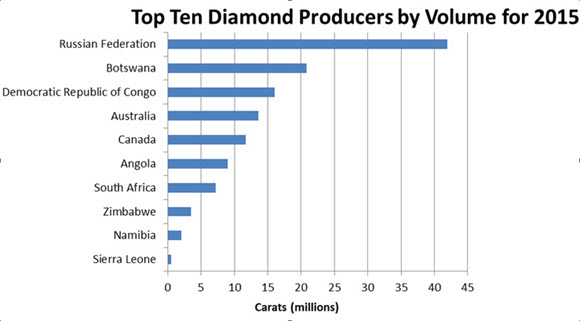Crater of Diamonds
Crater of Diamonds
Did you know that diamonds could be unearthed in the U.S.?
The biggest diamond found in the U.S. was 40.23 carats and was named “Uncle Sam” after the nickname of its finder, W.O. Basham. He found the diamond in 1924 at Murfreesboro State Park in Arkansas, now known as Crater of Diamonds State Park. In fact, there have been more than 75,000 diamonds found at the Crater of Diamonds State Park since farmer John Huddleston first discovered diamonds on his land in 1906.
When U.S. diamonds are exported, the U.S. Census Bureau counts them. Under the Clean Diamond Trade Act, the Census Bureau is the designated exporting authority and the Customs and Border Protection Agency is the importing authority. Ultimately, the Census Bureau’s International Trade Management Division is responsible for collecting, compiling and publishing import and export statistics under the provisions of Title 13, U.S. Code Chapter 9, and Title 15, CFR Part 30.
Rough diamonds entering or exiting the U.S. must be filed in accordance with the standards, practices and procedures of the Kimberley Process Certification Scheme set out in the Department of Treasury, Office of Foreign Assests Control, Rough Diamond Control Regulations.
According to statistics as of June 10, 2016, taken from the Kimberley Process Rough Diamond Statistics Website, the Russian Federation was the largest producer of rough diamonds by volume and value with 41.9 million carats, valued at $4.2 billion in 2015. Second by volume and value was Botswana with 20.8 million carats, valued at approximately $3 billion.
The U.S. was the ninth largest importer of rough diamonds by volume with 2.0 million carats valued at $343.5 million in value. The U.S. was ranked as the 17th largest exporter of rough diamonds with approximately 1.1 million carats valued at $180.4 million in 2015.
Source: Kimberley Process Certification Scheme dated June 10, 2016.
What do you get when you mix a park full of rough diamonds with a “finders keepers” policy? Diamond hunting!
For more information on trade data such as state imports and exports, emerging markets and top trading partners, visit <usatrade.census.gov/>.
For more information and access to data on rough diamonds, visit the Kimberley Process Rough Diamonds Statistics page at <kimberleyprocessstatistics.org/>.
To learn more about Crater of Diamonds State Park, visit <www.craterofdiamondsstatepark.com/>.
Also, check out these other Global Reach blog posts for more information:
-
Global Reach BlogCommodity Spotlight: DiamondsWe all know that diamonds are a girl’s best friend, but did you know that the United States imports billions (yes, billions with a B!) of dollars worth of diamonds every year? How many diamonds? The United States imported $23.4 billion worth of diamonds in 2013, which is an increase of 59% since 2004. That’s a lot of sparkle!
-
Global Reach BlogDo You Know the Requirements for Importing a Rough Diamond?Get foreign trade data reports, information on Trade Regulations and answers to your questions from the official source of US Import & Export Trade Statistics.
-
Global Reach BlogAre Your Rough DiamondsGet foreign trade data reports, information on Trade Regulations and answers to your questions from the official source of US Import & Export Trade Statistics.




